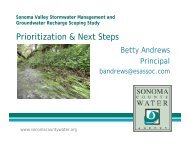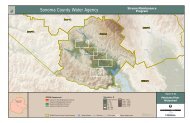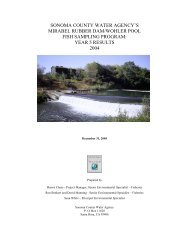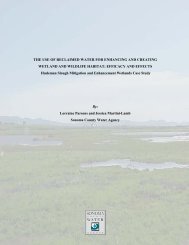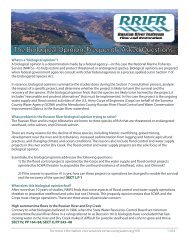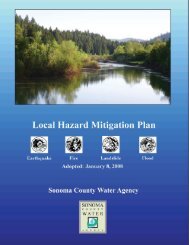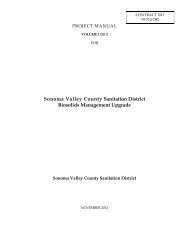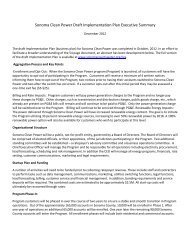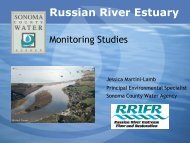Chapter 3 Water Reuse - Sonoma County Water Agency - State of ...
Chapter 3 Water Reuse - Sonoma County Water Agency - State of ...
Chapter 3 Water Reuse - Sonoma County Water Agency - State of ...
Create successful ePaper yourself
Turn your PDF publications into a flip-book with our unique Google optimized e-Paper software.
<strong>Water</strong> Smart Development Guidebook<br />
<strong>Chapter</strong> 3. <strong>Water</strong> <strong>Reuse</strong><br />
four homes which have been using graywater to irrigate their landscapes for more than five<br />
years. Results from this study should be available in 2011.<br />
Beyond the potential risk from pathogens, some graywater skeptics further argue that traces <strong>of</strong><br />
household and personal care products found in graywater constitute potential environmental<br />
pollutants. There are also concerns about proper installation and maintenance <strong>of</strong> graywater<br />
systems, including adequate cross connection control to ensure separation between potable<br />
and non‐potable water supplies. Additionally, if allowed to pool, whether in a storage tank or<br />
on the ground, graywater will become septic, create odors, and serve as a potential breeding<br />
ground for vectors such as mosquitoes. Since 2000, <strong>Sonoma</strong> <strong>County</strong> has received 340<br />
complaints about graywater, mostly from persons<br />
concerned about odors from their neighbor’s<br />
graywater system and graywater irrigation areas<br />
(personal communication with James Johnson,<br />
<strong>Sonoma</strong> <strong>County</strong> Permit and Resource Management<br />
Division).<br />
“There are eight million greywater systems in the US<br />
with 22 million users. In 60 years, there has been one<br />
billion system user‐years <strong>of</strong> exposure, yet there has not<br />
been one documented case <strong>of</strong> greywater transmitted<br />
illness.<br />
‐Art Ludwig, Oasis Design, www.oasisdesign.net<br />
Graywater advocates counter these concerns by pointing to empirical evidence provided by the<br />
many unpermitted graywater systems that are in current operation, and/or have operated for<br />
many years without creating public health issues. Because graywater is generally discharged<br />
onto the same property at which it is generated, any <strong>of</strong> the associated risks also remain onsite,<br />
incentivizing the property owner to properly construct and maintain the graywater system. In<br />
the LADWP pilot project described above, no human disease pathogens were found in the<br />
graywater drainage areas outside the homes (Haefele 2009).<br />
With the adoption <strong>of</strong> the 2010 Graywater Standards (see discussion below), California regulators<br />
have indicated that, in their best judgment, the benefits <strong>of</strong> expanding graywater use in the state<br />
outweigh the risks. The Building Standards Commission approved the 2010 Graywater<br />
Standards after testimony both for and against the code changes. Most resistance came from<br />
local building departments and plumber industry representatives. It is noted that the <strong>State</strong><br />
Department <strong>of</strong> Public Health supported the changes to the code (EBMUD 2009).<br />
3.3.2 Regulation and Implementation <strong>of</strong> Graywater Use in California<br />
Californians have likely used graywater systems in and around their homes for as long as there<br />
has been indoor plumbing. Only in the last few decades, however, has the <strong>State</strong> attempted to<br />
regulate the design and use <strong>of</strong> graywater systems. <strong>State</strong>wide regulations guiding graywater use<br />
have developed slowly as regulators weigh water conservation benefits against concerns about<br />
health and safety issues.<br />
California’s drought <strong>of</strong> the late 1980’s and early 1990s created interest in encouraging graywater<br />
use and formalizing guidelines and regulations for graywater system use and maintenance. As a<br />
result <strong>of</strong> the “Graywater Systems for Single Family Residences Act <strong>of</strong> 1992” (Assembly Bill 3518),<br />
the California Graywater Standards were adopted into the California Plumbing Code. In 1997,<br />
<strong>Sonoma</strong> <strong>County</strong> <strong>Water</strong> <strong>Agency</strong><br />
May 2011 3‐9




